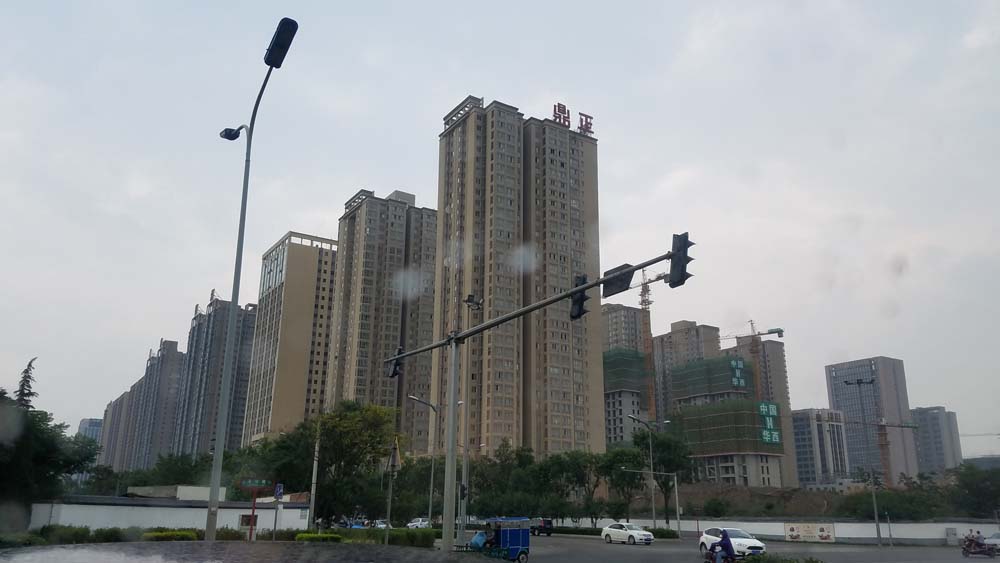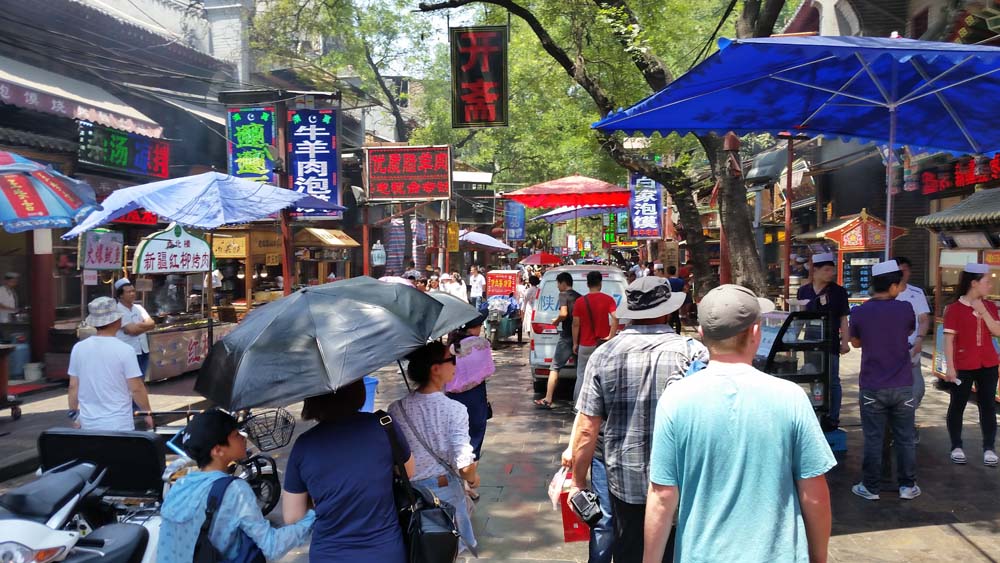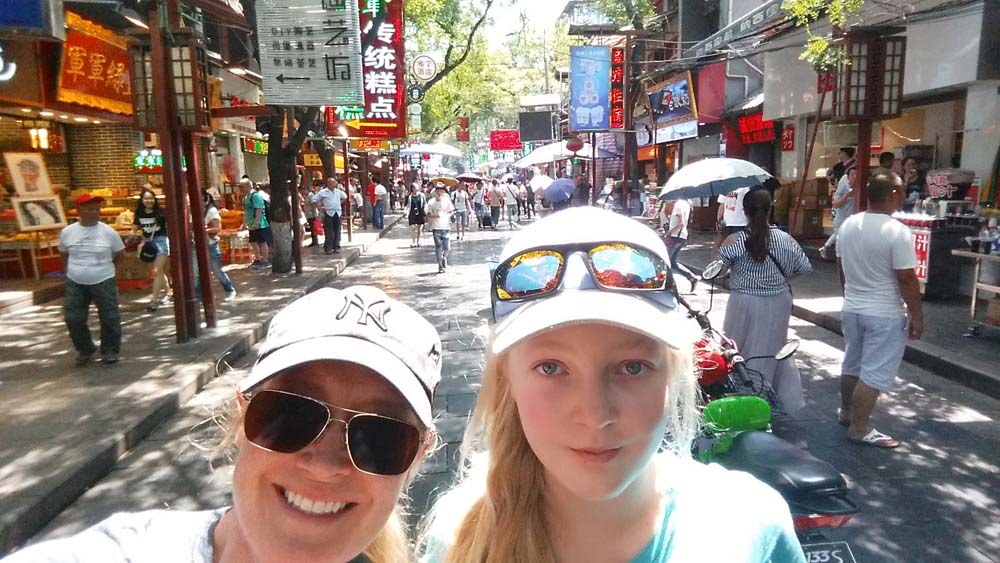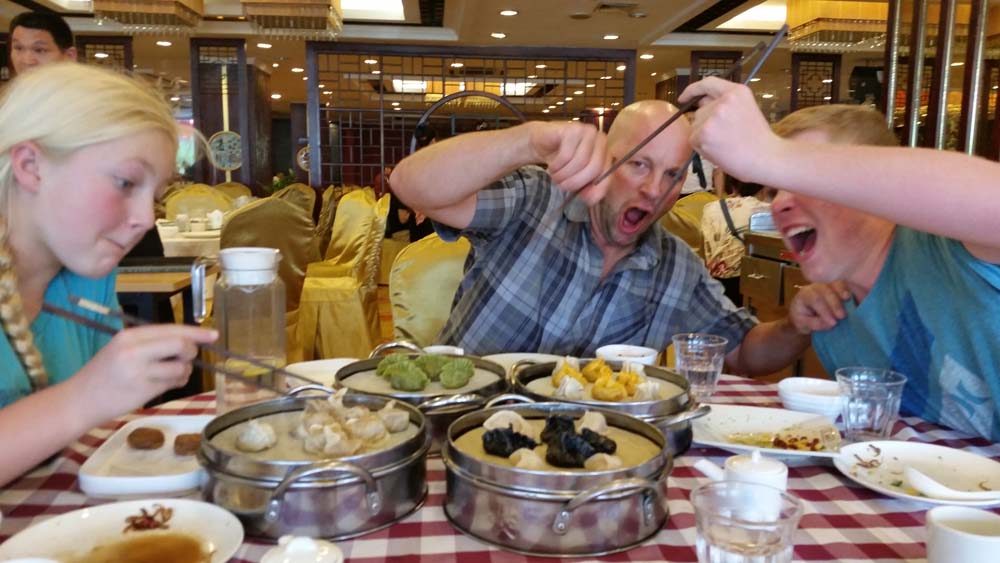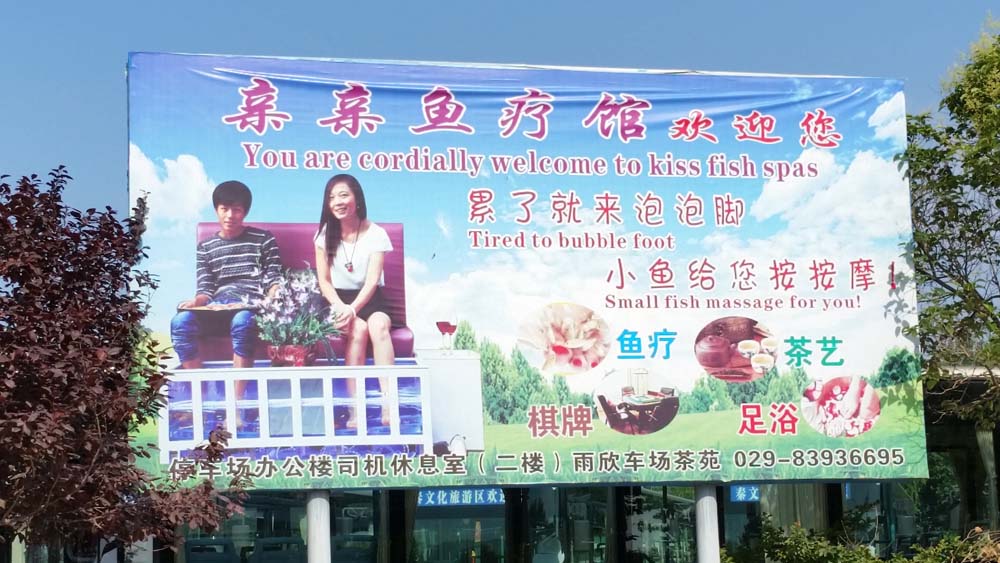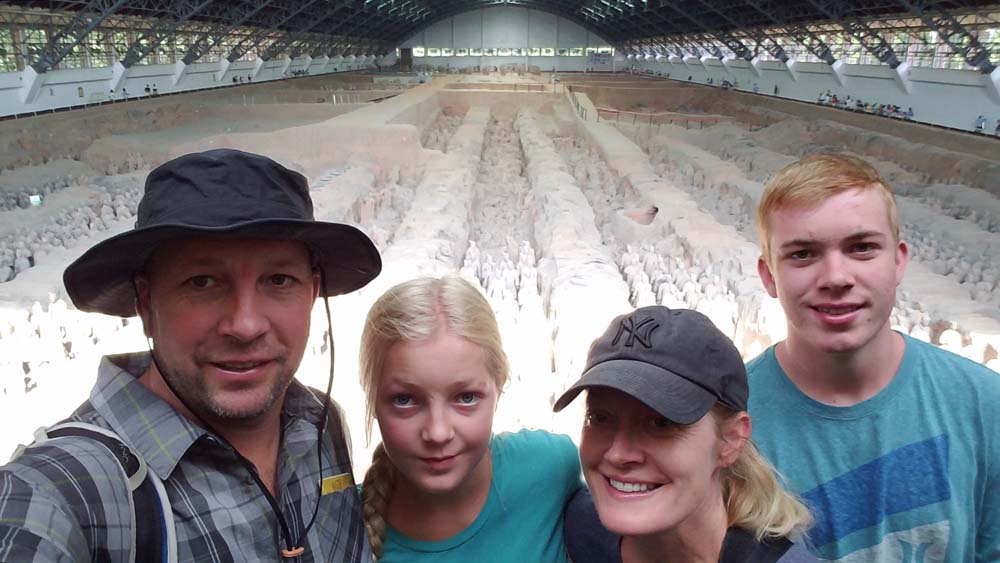 Adventuriety
Adventuriety
We arrived in Xi’an on our seventh day in China. Even if you have no interest in China you’ve probably heard of Xi’an. No? What about the Terra Cotta Warriors? I thought so. Even my kids knew about the Terra Cotta Warriors and listed them as a reason for visiting China. Obviously, Xi’an is very popular on the Chinese tourist circuit because of the Terra Cotta Warriors (hundreds of millions of dollars per year for the city popular, we’ll get into that a little later) which is why it was on our itinerary.
Valerie, tiny, vivacious and charming with a quick smile and even quicker wit that surfaced intermittently, would be our guide for about thirty six hours. She was in her late thirties and we knew this only because Scott accidentally asked her age by asking her zodiac sign. As soon as he realized what he’d done he quickly apologized, but Valerie said that the Chinese love to talk about themselves and in return are very nosy. She said asking someone’s zodiac sign is actually a Chinese trick to asking one’s age.
Valerie and Scott were the most entertaining part of Xian and the most interesting part (for me anyway)…I’ll save that for the end of the blog. Scott really wanted to visit China. Both his dad and sister, highly intellectual people, have enjoyed well researched trips to China. They found the country interesting, thought provoking and even important to see and understand. Scott’s dad suggested a book called River Town by Peter Hessler and Scott listened to it on our long flight to Tokyo. Before we left Japan, Scott downloaded hundreds of Wiki pages about all things China and to read when we were in China and so upon finally arriving, he was ready to have “discussions” with our guides and make some connections to what he had learned from his dad, sister, River Town and his own research.
Now, Scott likes to talk to the guides (every guide we have spent time with and not just in China) and is determined to have meaningful, thought provoking and “eye-opening” discussion with all of our guides. I support this, guides are usually well educated and passionate about what they are showing you and are good communicators so this has worked out well for him in other countries, too well in some like Peru. China is a little different and it’s been fun to listen in on some of his discussions with our guides. The guides so far have all been very well educated and will speak openly about some things, but there is no steering the conversation. We are on guide number three and you get just what they are willing to tell you based on their experiences. In this way, we are getting bits and pieces of a very large picture.
Right away and I can’t remember why, but Valerie told us that the Chinese are taught to hate the Japanese from a a very young age, it’s part of their education. She said she hated the Japanese until as an adult she had a chance to visit Japan with some girlfriends. She said that she was surprised at how kind the Japanese people were and told us a story. Her group was looking for a restaurant and they were lost and so they looked around for a nicely dressed person to ask because they had been taught that people in suits are professionals and will likely speak English. The man they asked did not speak English, but he took the time to walk them to the restaurant that they were looking for. Valerie said she couldn’t believe how polite the Japanese people were and how clean everything was. She told us that at that point she realized that her brain had been washed and that all of the Chinese children’s’ brains in China are washed.
She added that in general Chinese people don’t care about politics or politicians because it doesn’t matter. She said the same people are always in power and citizens have no power or vote in deciding leaders, so they ignore it all. Valerie also told us that the government is always watching and if you write something derogatory about the government on the internet, it will be erased in less than a minute. If you continue to write negative comments, someone will be knocking at your door. This type of conversation was just what Scott was looking for and so he asked her if she knew anything about the Cultural Revolution (zero to sixty, conversationally speaking here). She said she knows nothing but the one sentence that was in her text book in school citing the years 1966-1976 as the years that the Cultural Revolution took place. She said her mother lived through it but won’t talk about it and that was the end of the conversation. Later Scott tried again with a new subject, VPNs, a more modern topic, but still controversial. A virtual private network (VPN) is software that you download onto your phone or computer before entering the country and it is the only way to use the internet without restrictions in China. Valerie wouldn’t talk about that either. She just simply changed the subject.
As usual, there is no amount of reading that actually prepares me for the real thing and by Day Seven some realizations were soaking in. China is big and foreign, in a very foreign way. It is mind numbingly hot (so far) and loud and there really is so much traffic and even more pollution and consequences of pollution than Dr. Suess and the Lorax worried about. The factories spewing smoke are everywhere as are the massive housing developments that stretch out of sight.
This is the city wall in Xi’an. The city, approaching nine million is a medium sized city by Chinese standards and has a few more things to offer than just the Warriors. The city wall was built between 1374 and 1378 and is ten miles in circumference. Valerie helped us rent bikes and we rode all of the way around, even in the gale force wind (maybe a tiny bit of an exaggeration) and pouring rain. It wasn’t really busy on the wall, but the nasty weather cleared the lingering tourists and so it was a wet, wild and very fun ride that felt like us. Notice the buildings in all directions.
These are some of the views of the city outside of the wall that we had while we were riding the bikes. You can see the traffic congestion and the dome that is the Great Mosque. Yes, it is an Islamic Mosque in China, built in the Tang Dynasty (or at least parts of it, the mosque not the dynasty).
We walked through the grounds during prayer time and peeked into the Mosque where thousands of men were seated. What is a Mosque doing in China? Well, Islam was introduced in the 7th Century (Tang Dynasty) by Muslim traders along the Silk Road. By the Song Dynasty (960-1279), Muslims had made a great economic impact on the country through trade. Today, even though the the Chinese Communist Party is officially atheist, Islam is one of the five recognized religions in China ( Buddhism, Catholicism, Daoism, and Protestantism are the others).
After the Mosque, we walked through the Muslim Quarter, a teeming neighborhood full of shops and mostly delicious looking things to eat. We had just eaten though at Defachang, the city’s most popular dumpling house, and so we were content with just some peanut brittle type candy.
This dumpling mecca was housed over three busy floors of a large office building and was probably the thing that Grant was looking forward to more than visiting the Warriors. I’m sure the dumplings were delicious, but when it’s a million degrees outside nothing hot tastes that good.
And so what about those crazy warriors that had put China on our travel map for the year? We did visit them and it was…interesting to say the least, but mostly not for any of the reasons you may be thinking.
First of all the archaeological site is huge, together with burial tombs and architectural remains, totaling over 600 sites within the property area of 56.25 square kilometers (approx 35 sq miles) and located at the northern foot of Lishan Mountain (above), 35 traffic congested kilometers (21 miles) northeast of Xi’an.
The area was once all farmland which has been slowly taken away from the farmers and swapped out for shops in a newly built outdoor mall that comprises a very long exit walk. Tourists can take golf carts to the museum, but you must walk back to the parking areas passing the shops in the process. This sign is in the parking lot near the entrance of the museum.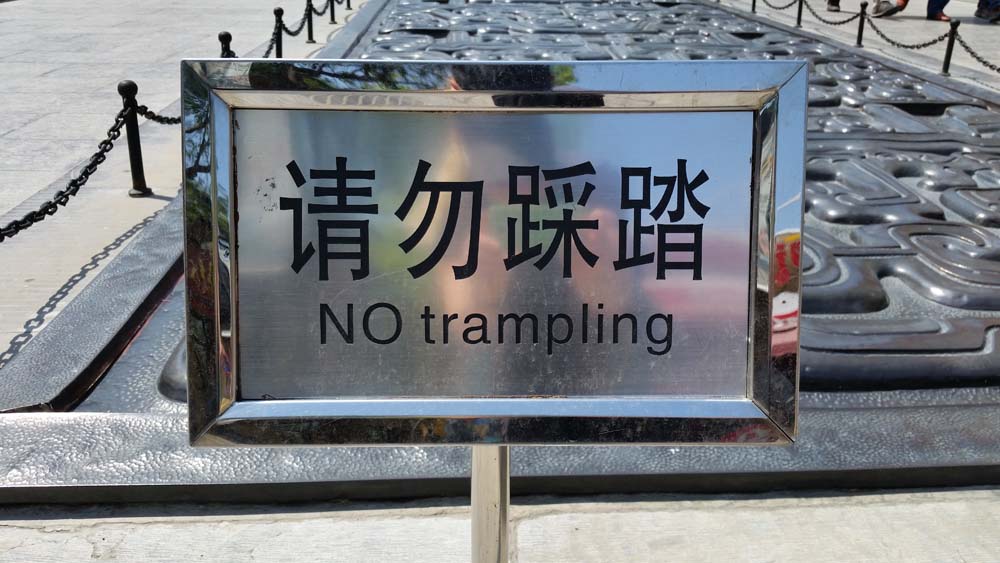
This piece of art was part of the walkway of shops. I couldn’t resist the sign.
Back to the warriors, but first just a tiny bit of history to set the stage. Xi’an has served as the capital city of thirteen imperial dynasties starting with the first dynasty, the Qin (pronounced Chin and from whence the name China came) Dynasty in 220 BC. The Qin Dynasty was founded by the very intelligent and ruthless, Qin Shi Huang. He was born a prince of the State of Qin, became king when he was thirteen, and by the time he was thirty-eight in 220 BC, he had conquered and unified the Warring States after 200 years of conflict and unified all of China. He called himself the First Emperor of China and ruled from 221-210 BC. During his reign, China experienced great advances in many areas. He reorganized the government and standardized weights, measures, currency and Chinese writing. He was also a prolific and ambitious builder. He transformed the wall segments built by the Warring States into The Great Wall of China, constructed national road and canal systems and prepared for his afterlife by building a gigantic tomb including an underground palace yet to be unearthed. He was ruthless as well as intelligent. He burned books and buried scholars alive, he worked his people relentlessly through hard labor in the name of his projects, heavy taxes, and rigorous law and military service. Regardless of his contributions, he was not a beloved leader.
Emperor Qin’s final resting place took over 700,000 slaves almost forty years to complete. The estimated 6,000 bigger than life size (the better to protect him) Terra Cotta Warriors quietly guard Emperor Qin in the afterlife, along with everything else that he might want or need (and he had some outrageous wants and needs).
This is Pit Number 1 where the pieces of the soldiers have been excavated, restored and replaced in their original positions. The building is huge and we walked all of the way around the inside perimeter.
At one end of the huge structure that covers Pit Number 1, restoration is ongoing.
Valerie joked that this was the hospital, notice the hospital bed?
And this is the ICU, for the very sick patients.
This is Pit Number 3, it is much smaller than Pits 1 and 2 and is thought to be the headquarters of the “afterlife army.” Here we noticed barricades being set up and people being herded in one direction. At this point Valerie knew something was up and we rushed to see Pit Number 2, as she explained that the museum gets shut down without notice for “high ranking officials” (a phrase we were hearing often) and if you are unlucky enough to visit in the wake of someone important, you will be waiting outside for at least two hours while the private tour is conducted. We sprinted toward the last pit.
Valerie transformed into uber tour guide and both charmed and bullied us past grumpy guards at Pit Number 2 so we could see some of the most impressive warriors protected by glass encasement. She wanted us to see the details of the fingernails up close and some of the paint that had been preserved.
Pit Number 2 is supposedly the most impressive site where the best stuff has been found as far as high ranking soldiers, weapons, horses, chariots and significant formations.
It was a gruesome business, not only were lives,years and resources spent creating this other world, but when the emperor died, living concubines, animals both real and clay, and architects of the tombs who knew too much, were sealed in the tombs and buried with the emperor. Not long after Qin’s death the tombs were raided for the real weapons that the clay soldiers carried and the soldiers were smashed.
Some clay pieces were discovered almost 2,000 years later in 1974 by farmers digging a well. Three pits were excavated and the four-acre Museum of the Terra Cotta Army was constructed around those pits at the discovery site and opened in 1979. Many of the tombs including the emperor’s tomb and possible palace have not been excavated. Scientists do not feel that preservation techniques are advanced enough to risk destroying the artifacts. Of course the mercury rivers running through the site might be reason for concern as well.
So there you have it, the Terra Cotta Warrior in all of their glory…or is it? We met a really cool woman on our Grand Canyon trip. She was a retired attorney and investigator for the Navy and had traveled extensively over the years. Every place in the world that I could think of, she had been and had something to say about it. Her opinion was that the Terra Cotta Warriors were a very intelligent and lucrative scheme. Considering the amount of replication that we had witnessed in only one week and the hundreds of millions of dollars in tourism that are generated yearly, her theory is believable, especially when one can buy perfect replicas of the warriors or horses in the gift shop at the museum for about 7,000 US Dollars, shipping included. Regardless of the authenticity of Qin’s afterlife extravaganza, the whole thing is impressive. If it’s real, wow and if it’s not, still wow for other reasons. Either way, I didn’t like it because it made me sad. It made me feel empty to think of someone so infinitely soulless and selfish and excessive. Obviously, others agreed because the Qin dynasty was overthrown soon after Qin Shi Huang’s death.
We visited another archaeological site, the Han Yangling Excavation Museum. I think we were the only people there which was surprising because it was really cool. The museum is built underground and is interesting for that reason alone. On the historical side, it is the tomb of Han Dynasty Emperor Jingdi (188-141).
The walkways are glass and built over the excavation sites.
Similar to Qin Shi Huang’s tomb, everything needed for the afterlife is buried here with Jingdi, only this emperor does not seem to have such extravagant needs. In life, as in death Jingdi was a much less complicated ruler. He was influenced by Taoism and based his rule on noninterference. He didn’t really improve his subjects’ lives but he did lower taxes, used diplomacy instead of military force and even reduced punishments of criminals. Valerie was telling us about all of the people and animal statues that were buried along with the emperor and she mentioned men, women and eunuchs. I asked her how one might distinguish the difference and she just smiled and said, “I’ll show you.”
We got to see where and how the artifacts that are still being excavated are cleaned and restored.
The number of artifacts just lying around in plastic boxes is a bit disturbing.
Xi’an was a long way to travel for the Terra Cotta Warriors. The city is sprawling, polluted, congested and hot as hell in the summer. Would I ever do that again on purpose? Probably not, but I’m realizing as we go that one needs a lot of experiences to understand anything of importance and the best experiences are usually found in places you don’t expect to find them. I’m speaking very broadly here, as in applicable to life, not just China. In Xi’an I started moving my China puzzle pieces around trying to fit them together. Part of the picture that is emerging is that I do not want my brain to be washed. I want to see things and ask questions and care about the answers but what is real is not always easy to see. So much in China is replicated, so much is deleted from history and is that simply becoming part of China’s history? The warriors and what they represent (real or fake) is mind boggling and I find myself asking again, what or who is “bad” when it comes to history and what is real?



